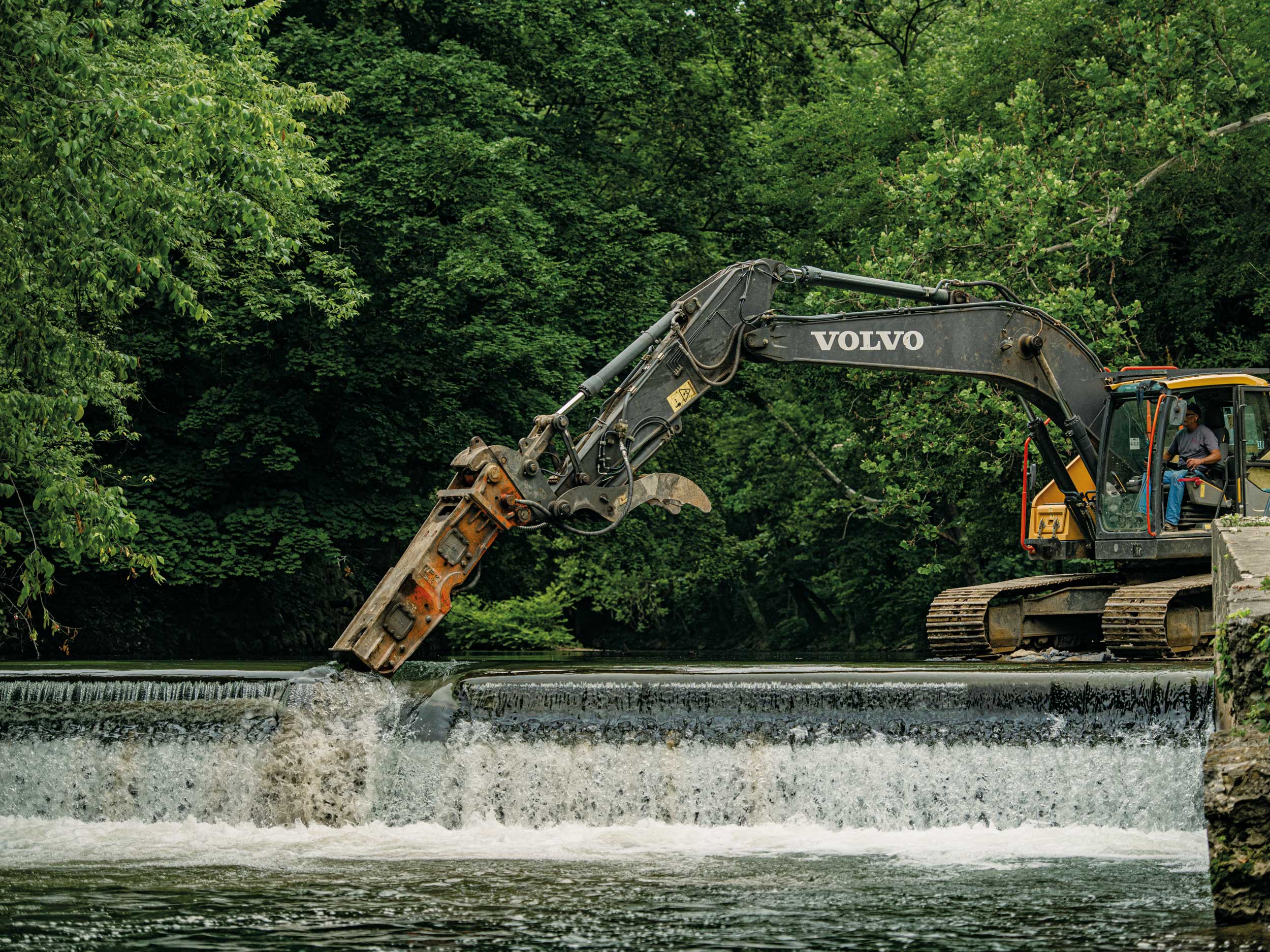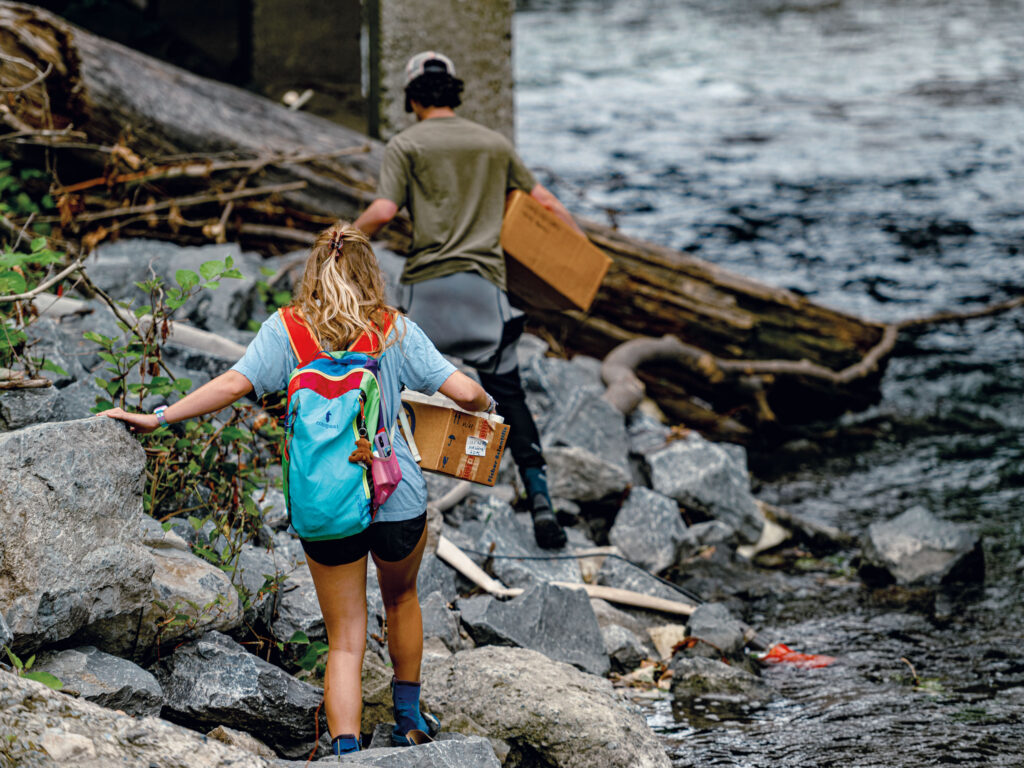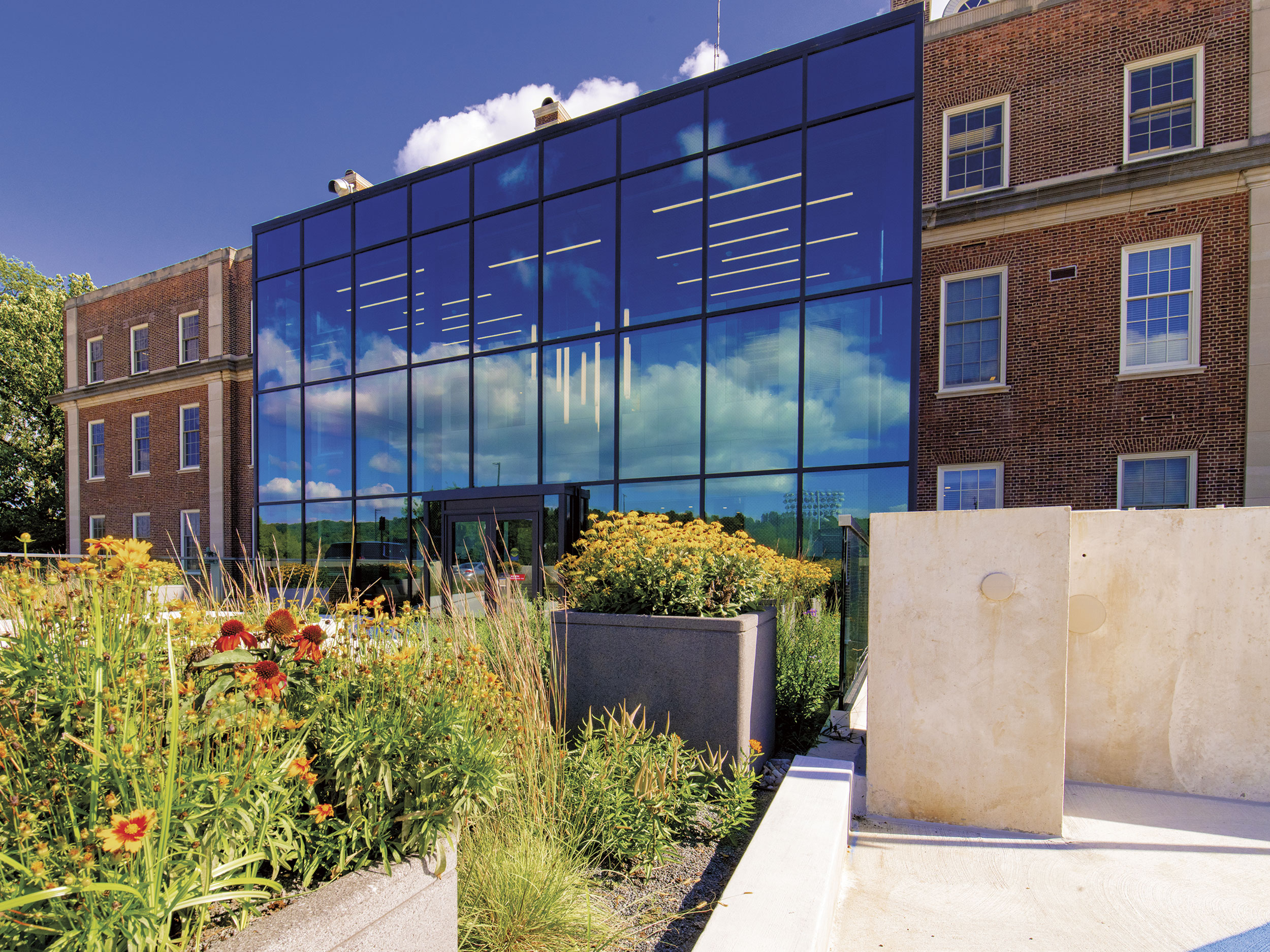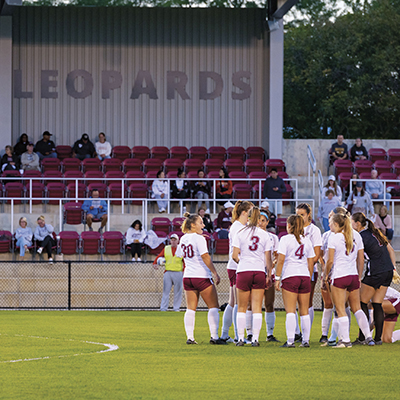
Photographs by adam atkinson
A watershed moment
Recent dam removals along Bushkill Creek in Easton are leading to a critical return of freshwater mussels in the area. Lafayette’s initiative at the base of campus is years in the making—and a call for other communities around the world to reconsider their own waterway restoration.
Freshwater mussels, the unsung bivalves with an oversized role in filtering and purifying water, are essential to the environment. Near Lafayette, however, their egress into Bushkill Creek, a watershed encompassing 80 square miles from Blue Mountain to the Delaware River in Easton, has been blocked for more than 100 years after a series of dams was constructed for milling. Due to dams and water pollution, freshwater mussels everywhere are facing a troubling future: According to the U.S. Fish and Wildlife Service, more than 70% of approximately 300 species in North America are considered endangered, threatened, or of special concern. Thankfully, over the past few months, a Lafayette-supported project led by the Wildlands Conservancy, and involving numerous government agencies and conservation organizations, has been removing dams to remedy the waterway, restore freshwater mussels, and improve the overall health of this creek.
Nearly 20 years in the making, the project emerged from a legal settlement stemming from a 2005 coal ash slurry spill at a coal-fired power plant on the Delaware River about 10 miles north of Easton. The nearly $1 million mitigation settlement was mostly designated to fund mussel restoration and removal of the Bushkill Creek dams, including the one owned by Lafayette behind its Film and Media Studies building on North Third Street. Separately, the Wildlands Conservancy secured nearly $2 million in grants and other funding to support the project. (Learn more about the timeline of this project.)
On July 7, using a hydraulic pick, crews started to safely remove the Lafayette dam, the first—and most critical—of a series of dams upstream of the confluence of the Bushkill and the Delaware. Later, in September, the dam at the Simon Silk Mill was removed. And the Easton-owned dam, located between these two sites, is scheduled to come down next summer. The Wildlands Conservancy removed two additional dams on Bushkill Creek in 2021.
By fall, rippling water was flowing smoothly and evenly as if no human-made obstruction had ever been there. The stream channel is adjusting to its restored natural flow, and floodplain capacity has been enhanced. Despite several heavy rainstorms in late summer, the creek has handled the high flow very well.
There’s still work to do. As funding becomes available, the Wildlands Conservancy plans to remove a fourth upstream dam and install instream habitat at another nearby preserve. While the Delaware River Basin Commission is selecting a partner for the introduction of freshwater mussels in 2024, the conservancy is partnering with Lafayette to manage the invasive species along the stream banks and restore the riparian buffer with native trees, shrubs, and wildflowers.
Along the trail and stream corridor, birds, pollinators, and other wildlife will benefit from native buffers. Fish will be able to migrate from the Delaware River, and the restored instream habitat will now create sustainable conditions for cold water fish species, including trout, creating improved fishing opportunities. In addition to providing a healthier stream for recreation, erosion will be controlled along the banks and Karl Stirner Arts Trail.
The initiative is about environmental stewardship, but it’s creating a restorative nature for humans as well. “The benefits that people derive from a stream, psychologically and emotionally, to be able to come down here and just sit or to fish, it does wonders,” says Dru Germanoski, Dr. Ervin R. Van Artsdalen Professor of Geology. “It’s a place to nourish our emotional health.”
“The long process to get to the point of dam removal is a great example of the perserverance often necessary to effect environmental change,” Brandes says.
The Bushkill project has provided an opportunity for the College to offer rich interdisciplinary collaborations, bringing together faculty and students in biology, civil and integrative engineering, geology, and economics. For almost 15 years, they have examined and studied the effects of removing the dams, gathering valuable data that will support and inspire similar projects in the future. “Lafayette College has done a tremendous job engaging their students in the many aspects of the project and helping them gain real-world experience,” says Kristie Fach, director of ecological restoration with the Wildlands Conservancy. She adds that these years of stream monitoring have provided a detailed record of pre-project conditions and stream ecology. “We are excited to be able to compare and quantify the benefits of the dam removals and use this as a model for future stream restoration projects,” Fach says.
Since 2010, students of Megan Rothenberger ’02, associate professor of biology and chair of environmental programs, have been wading in the Bushkill collecting data in preparation for these dam removals. “When I was a student here, there weren’t as many interdisciplinary programs as there are now,” she says. However, she explains, the Bushkill Creek dam removals have been a really good example of a problem that needs various kinds of expertise in order to address the full scope of the issue. “It isn’t just a science problem. It isn’t just an economics problem,” says Rothenberger, adding that it’s been gratifying to see students who have worked on this project in her lab to interact with other departments from engineering to geology. “It’s the kind of stuff I love and what makes the Lafayette experience so unique.”
Mussels, which burrow into sediment and help with nutrient recycling and decomposition, create habitats that are used by other aquatic freshwater species and are considered a keystone species in rivers and streams. (They are vital to the ecosystem and represent a freshwater version of coral reefs.) “Nobody really thinks about mussels, because they’re just there. It’s not like they move around like fish or frogs,” Rothenberger says. “But they’re one of the most threatened species of animals. And the main threat to mussels is dams.”
Mussel larvae are parasitic, but only temporarily. They attach to the gills of fish that swim up and down rivers and streams. Once they get upstream into a new habitat, they drop off the gills, never harming their host, and grow into adults. Long-lived mussels can survive up to 200 years; the bivalves in the Delaware River below the confluence with the Bushkill are abundant. “But if dams are blocking the streams and the fish aren’t able to move up and down, then neither can the mussels,” Rothenberger says.
Eurnett Christopher ’25, who’s pursuing a degree in environmental science with a data science minor, joined Rothenberger’s lab last spring to study the effects of low-head dams on the physical and ecological structure of Bushkill Creek. She understands the significant importance of the initiative: In addition to restoring the natural flow regime and migration of fish species, says Christopher, mussel restoration efforts will likely improve water chemistry and aquatic food webs in the Bushkill Creek.
Their pre- and post-removal monitoring will allow them to assess all of this information—and, hopefully, inspire other communities to remove their dams. “We rely heavily on the ecological and economic services provided by freshwater mussels,” Christopher says. “Restoration of these extraordinary creatures is just the beginning for Bushkill Creek.”
Hongxing Liu, assistant professor of economics, also sees the opportunity within this interdisciplinary project, particularly with biology, and how housing market data and water quality data have merged together to support her socioeconomic research with her students. “We’re looking at the housing values around the creek,” she says, “to see how the dam removal is capitalized in the housing market.” When the water quality is better, Liu explains, the housing prices are typically higher. They’ve also been surveying Easton residents to gauge how their behaviors and activities have been influenced by the dam removals, considering the changes in aesthetics, water quality, and recreation. “These are things that you can’t directly measure from scientific measurements of water quality,” Liu says. “It’s just so exciting to see it happen.”
It’s a blazing hot late spring day on the Bushkill Creek at Lafayette’s dam, an appropriate backdrop for the kind of gritty learning that makes Lafayette classes and labs come alive.
Removing a machete from his pack of gear, a khaki-and-camouflage-clad Germanoski takes several hearty whacks at Japanese knotweed, a thick, reedy invasive plant that chokes the stream banks. He clears enough of it to make room for the geology and engineering students to move around safely and place their equipment.
Out on the creek, above the dam, David Brandes, professor of civil and environmental engineering and Walter A. Scott Chair of Integrative Engineering, is in a kayak helping his students position and secure a line to an eyebolt, allowing consistent surveying over time of cross sections of the creek both above and below the dam.
Germanoski, with his students, is gathering data on how the streambed and hydraulics will change with removal of the dam as sediment disperses with the creek’s elevation shifts. “That sediment will start to get eroded because the energy of flow is proportional to the slope,” he says. “And that’ll cause sediment to erode upstream of the dam. This stream will eventually create its own sort of natural gradient, or slope, that will basically be a new equilibrium.”
Germanoski also observes the pools in the less active water above the dam; they warm up in the summer and affect the migration of trout trapped in that area. “Every time you’re taking a dam out, you’re opening up passage for the fish,” he says. “So that movement is really important to the fish. This allows temperature-stressed fish in warmer pools to move freely to find cold water during the heat of summer.” He adds that, during spawning season, fish will be able to migrate into Bushkill Creek from the Delaware River, which helps both the Bushkill and other fisheries throughout the Delaware River.
“The long process to get to the point of dam removal is a great example of the perserverance often necessary to effect environmental change,” Brandes says.
While people often associate dams with flood control or flow management, Germanoski notes that these Bushkill dams play no positive role in flood control. “They were not constructed to provide any flood protection. They have very little water storage capacity and do not provide any real measure of flood control,” he says. “In fact, dam removal will reduce local flood impacts. The channel can convey more water within the channel without flooding.”
Navigating his kayak to shore, Brandes takes a philosophical view of all the interdisciplinary work that’s been done by Lafayette over the years. “Part of it is environmental stewardship and giving something back to the larger community. The Bushkill Creek is our neighbor, our natural boundary between campus and the city of Easton,” he says. “I think it’s fair to say, it was essentially ignored by almost everybody until the Karl Stirner Arts Trail was established in 2011; soon after we started conversations about dam removal on the lower Bushkill.”
Access to the stream from the trail has brought to light its potential as a recreational green space, and so removal of these dams will continue the work of connecting people to nature in a mostly urban environment, Brandes says, adding, “that’s what makes this project so important.”
“Our hope is that the project will encourage others to invest more in the stream as an asset to our community, rather than letting it remain a forgotten industrial corridor,” he says. “I have had several teams of students, in engineering courses and environmental studies capstone, contribute fabulous ideas to what this place could look like.” He adds that while many in and around campus might not even know the dams existed, it’s easy to imagine, for example, sitting on a deck above the former site and enjoying lunch and a cold beverage while listening to the sound of water running over the rocks.
“The fact that it’s so close to campus just makes it an incredibly great opportunity for students to get involved in meaningful multidisciplinary research. This is the kind of project where collaboration and commitment of many partners with differing expertise are needed,” Brandes says. “The long process it took us to finally get to the point of dam removal is a great example of the perseverance that is often necessary to effect environmental change.”
Nearby, integrative engineering major Liam Thompson ’24 is in a wetsuit helping guide the line; he’s interacting with geology students and appreciating the symmetry of a familial discipline and finding shared areas of expertise. “It’s cool because they have a similar background,” he says. “They work with a lot of the same stuff that we use to build. We’re all kind of doing the same thing, right? They’re doing geology and we’re doing engineering, and we share a common language. It all fits.”
Thompson is with Elise Walsh ’25 (geology), Eve Bertoni ’25 (civil engineering), and Taylor Wininger-Sieve ’26 (geology). “It’s fun being in the water. I can see myself doing a job like this after Lafayette,” Walsh says. “Lots of problem-solving and collaboration with engineering.”
Bertoni, positioning her surveying equipment, agrees: “Outside and hands on, what could be better?”
Likewise, Germanoski is grateful for the opportunity to work alongside Brandes and Rothenberger for so many years on the Bushkill project, sharing a common interest in helping restore the creek. “Everything is so multidisciplinary and multifaceted that it’s just necessary we think across the boundaries and how projects like these benefit students,” he says. “Students learned that even though they each have a little bit of a different expertise, they overlap and they come together and enhance one another. They discover that the whole is more than the sum of the parts. It’s really beautiful.”

Wild Ride
Freshwater mussels have an important job: They improve habitats for creatures, like fish and snails, and clean waterways by filtering out things like algae and bacteria. Inside the fascinating life cycle of freshwater mussels—one of the most imperiled animal groups in North America.—Amy Downey
1.
Freshwater mussels can have a fleshy tissue that resembles a worm or minnow. Despite not having eyes or brains, it knows how to attract bigger fish that are looking to eat.
2.
Once predators bite at the tissue—or try to pry open the shell—the mother mussels spit out their larvae, sending them into the mouths of fish like bass. Now, inside the host, these larvae latch onto the gills.
3.
Larvae feed off nutrients from their host while being transported upstream. If there are waterway issues, like dams, they are unable to complete their life cycle.
4.
After a few weeks of traveling and growing, the freshwater mussels are large enough to go out on their own. Now “juveniles,” they unlatch from their host and settle into the bottom of rivers or lakes.
5.
If their life cycle has made it upstream, and they are able to continue reproducing, mussels are capable of living a very long life—some can survive up to 200 years.







